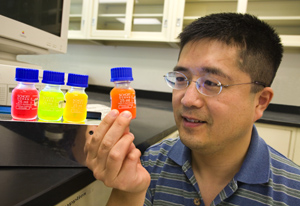Dr. Fanqing “Frank” Chen
The article Nano-Probes Allow an Inside Look at Cell Nuclei began with
“Nanotechnology may be in its infancy, but biologists may soon use it to watch the inner workings of a living cell like never before. Scientists at the U.S. Department of Energy’s Lawrence Berkeley National Laboratory (Berkeley Lab) have developed a way to sneak nano-sized probes inside cell nuclei where they can track life’s fundamental processes, such as DNA repair, for hours on end.‘Our work represents the first time a biologist can image long-term phenomena within the nuclei of living cells’, says Fanqing Chen of Berkeley Lab’s Life Sciences Division, who developed the technique with Daniele Gerion of Lawrence Livermore National Laboratory.”
Dr. Fanqing “Frank” Chen has a broad research interest, including nanotechnology, chemistry, radiation, space biology, cancer, and bioinformatics. His research has been funded by DARPA, U.S. Army, Department of Energy (DOE), National Institute of Health, and NASA.
Frank is on the Editorial Board of Nanotoxicology, the first journal fully dedicated to nanotoxicity. He is also a scientist with the Life Sciences Division of Lawrence Berkeley National Laboratory at the University of California. He is affiliated with the Molecular Foundry (one of the few national nanofabrication facilities in the DOE) in Lawrence Berkeley National Laboratory. His main interest is nano-bio hybrid for large scale biological Life Sciences Division and interrogation, clinical imaging, synthetic nanostructure with biological functions, and nano-to-bio translational effort. He is also the first one to use quantitative biology approach to decipher the health impact of carbon nanomaterials at the genome and proteomic level, which was highlighted in the Washington Post article Nanotechnology Regulation Needed, Critics Say.
He coauthored A nanoplasmonic molecular ruler for measuring nuclease activity and DNA footprinting in Nature Nanotechnology, Molecular Characterization of the Cytotoxic Mechanism of Multiwall Carbon Nanotubes and Nano-Onions on Human Skin Fibroblast and Fluorescent CdSe/ZnS Nanocrystal-Peptide Conjugates for Long-term, Nontoxic Imaging and Nuclear Targeting in Living Cells in Nano Letters, Gene expression changes in normal human skin fibroblasts induced by HZE-particle radiation in Radiation Research, and The Three-dimensional Structure of the C-terminal DNA-binding Domain of Human Ku70 in the Journal of Biological Chemistry.
Frank is a member of the Comprehensive Cancer Center at UCSF, a National Cancer Institute-funded Cancer Center. He is an active participating investigator of the National Cancer Institute (NCI) Breast Cancer SPORE program (NCI specialized program of research excellence) and Prostate Cancer SPORE at UCSF. He also holds adjunct professor positions in School of Public Health in Zhejiang University, China, and is visiting professor at Fudan University, China.
Frank has consulted for the California State Discovery Fund and the Medical Research Council of UK. He has reviewed for scientific journals, such as Nano Letters, TALANTA, Journal of Combinatorial Chemistry and many others. He received his BA on Biochemistry from Fudan University in China in 1991 and PhD on Biomedical Sciences and Technology from Los Alamos National Laboratory, UC in 1997.
Read his LinkedIn profile.
